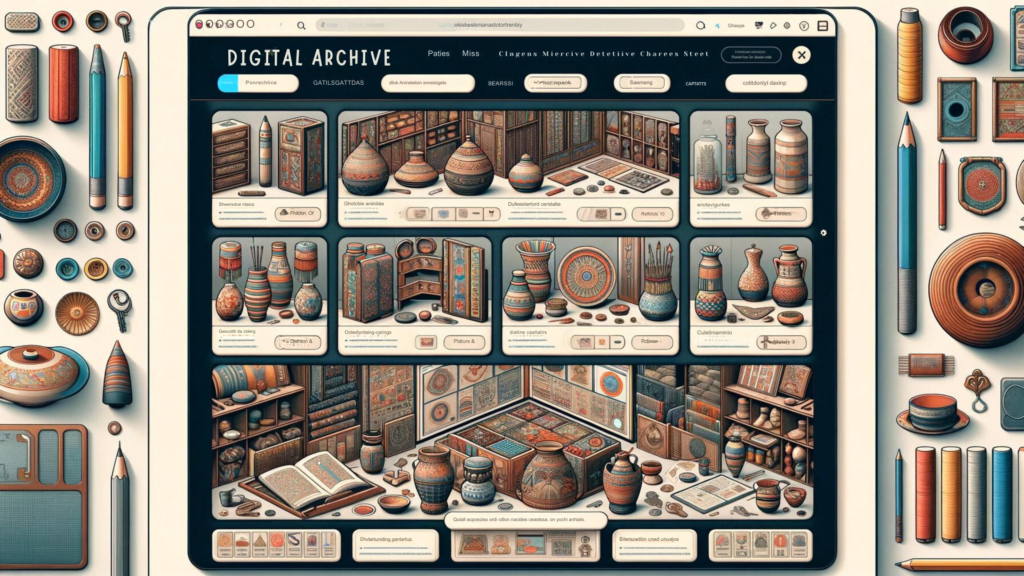In a world rapidly advancing towards a digital future, the echoes of our past—traditional crafts that have been the backbone of cultural heritage for centuries—are at risk of fading into oblivion. These crafts are not just hobbies or pastimes; they are stories, traditions, and a way of life for many communities around the globe. Fortunately, a bridge between the past and future is being built through digital archiving, a method that uses modern technology to preserve these priceless cultural treasures for posterity.
The Significance of Digital Archiving
Digital archiving involves collecting, documenting, and storing the essence of traditional crafts in digital form. This could mean capturing everything from the vibrant threads in a handwoven textile to the meticulous strokes of a brush on pottery. The aim is to ensure that the knowledge, skills, and cultural values embedded in these crafts do not disappear with time but are preserved in the digital ether, accessible to all.

Capturing Craftsmanship in Pixels
- High-Resolution Photography and Videography: Imagine being able to see the intricate patterns of a traditional fabric or the fine details of a ceramic vase from halfway across the world. High-resolution images and videos make this possible, providing a visual feast that brings every nuance of these crafts to life.
- 3D Scanning and Modelling: Beyond mere images, 3D scanning allows us to create digital replicas of physical objects. These models can be rotated, zoomed, and explored in detail, offering insights into the craftsmanship and history of the object that would otherwise require physical handling.
- Digital Databases and Catalogs: The heart of digital archiving lies in its organization. Through carefully curated databases, anyone from scholars to curious individuals can dive into the rich tapestry of traditional crafts, learning about their cultural context, techniques, and stories.
Impact and Importance
The digital archiving of traditional crafts does more than preserve the physical aspects of these arts; it captures the soul and story behind each piece. This method serves as a lifeline for vanishing techniques, ensuring that the wisdom of older generations is not lost but shared. For educators and students, it provides a treasure trove of resources that make learning about cultural heritage interactive and engaging. Perhaps most importantly, it democratizes access to these crafts.
Through digital archives, anyone with internet access can explore the beauty of crafts from cultures vastly different from their own, fostering a global appreciation and understanding of cultural diversity. It also offers tangible support to contemporary artisans, showcasing their work on a global stage and connecting them with patrons and enthusiasts who value the depth and tradition behind each piece.

Challenges and Considerations
Embarking on digital archiving projects is no small feat. The initial setup requires substantial investment in high-quality photography, 3D scanning equipment, and the development of intuitive, user-friendly databases. Moreover, the digital realm is ever-evolving, with the looming threat of technological obsolescence. Ensuring that digital archives remain accessible and up-to-date with changing technologies is an ongoing challenge. Additionally, the process of digital archiving must be approached with sensitivity and respect. It involves engaging closely with artisan communities, understanding the cultural significance of their crafts, and ensuring their stories are told accurately and ethically. Balancing these considerations requires a thoughtful approach that values collaboration and consent.
Conclusion
The digital archiving of traditional crafts represents a critical intersection of technology and cultural preservation. It is a testament to humanity’s ingenuity and dedication to safeguarding our collective heritage. As we continue to navigate the digital age, the importance of these archives cannot be overstated. They stand as vibrant repositories of human creativity and cultural memory, accessible to anyone curious enough to explore them. In preserving the intricate details of traditional crafts, we ensure that the beauty, diversity, and wisdom of our global heritage continue to inspire and educate future generations.

Author’s Note
In this digital era, where the new often overshadows the old, it’s crucial that we pause and reflect on the rich heritage that shapes us. This blog series is a small step towards bridging the gap between the ancient art of traditional crafts and the boundless possibilities offered by modern technology. I invite you, the reader, to join us on this journey of discovery and preservation.
Let’s explore together how digital archiving not only saves the past for the future but also connects us more deeply to the stories and traditions that unite us across time and space. Stay tuned for our next exploration, where we’ll delve into the fascinating world of technological innovations that are revitalizing traditional crafts in ways previously unimaginable.
G.C., Ecosociosphere contributor.
References and Further Reading
- “Digital Heritage: Preserving Culture in the Digital Age” – An exploration of digital archiving methodologies.
- “The Modern Artisan: A Comprehensive Guide to Handmade Crafts in the 21st Century” – A handbook for craftspeople looking to digitize their work.
- Google Arts & Culture’s Traditional Crafts Section – An example of a digital archive that brings global crafts to a wide audience.
By embracing the digital preservation of traditional crafts, we bridge the gap between past and present, ensuring that the legacy of artisans is cherished and shared far into the future.





Comments
Your article helped me a lot, is there any more related content? Thanks!
Your point of view caught my eye and was very interesting. Thanks. I have a question for you. https://accounts.binance.com/sl/register?ref=PORL8W0Z
Your article helped me a lot, is there any more related content? Thanks!
Can you be more specific about the content of your article? After reading it, I still have some doubts. Hope you can help me.
Your point of view caught my eye and was very interesting. Thanks. I have a question for you. https://www.binance.com/en-IN/register?ref=UM6SMJM3
Your point of view caught my eye and was very interesting. Thanks. I have a question for you. https://accounts.binance.com/en-ZA/register?ref=JHQQKNKN
I don’t think the title of your article matches the content lol. Just kidding, mainly because I had some doubts after reading the article.
Thank you for your sharing. I am worried that I lack creative ideas. It is your article that makes me full of hope. Thank you. But, I have a question, can you help me?